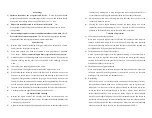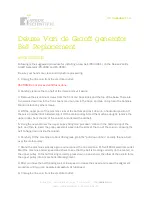
8. Trouble shooting
(1)
Common Problems
a.
There are surface pollutants on the electrode balls, the rubber belt, or upper
and lower rollers.
b.
There are current leakages caused by pollutants on the inside or outside
surfaces of the organic glass tube.
c.
The rubber belt is extended so that it is too loose.
d.
The upper and lower combs are not parallel and the friction surface is too
small.
e.
The distance between the collecting comb and the rubber belt is too large, or
their positions are not correct.
f.
Point discharges are produced because of the break of connecting wires.
g.
Humidity is too high.
(2) Advanced Trouble shooting
a.
Remove the upper dome half of the electrode and the upper roller. Open the
base / main console cover (underneath) and remove the rubber belt.
b.
Clean the upper and lower rollers, the rubber belt, and the Plexiglas tube
with a piece of clean, damp silk fabric.
c.
Replace the base cover after proper dry time, keeping the upper roller
parallel to the lower. Insure the rubber belt is snug, and position the
collecting comb in very close proximity (not touching) to the rubber belt.
d.
Let the instrument run for a few minutes leaving the upper dome off, so that
the bulb located in the base has a chance to exhaust as much moisture as
possible.
e.
Assemble the upper dome half, and proceed to use.
9. Miscellaneous
(1) When the instrument is not in use for a long time, you should reduce the
height of the upper roller to reduce tension on the rubber belt.
(2)
This instrument is designed for intermittent use, and leaving the device running
for long periods of time is not recommended.
VAN DE GRAAF GENERATOR
MODEL LC2910-HC
1. Purpose
The LC2910-HC model Van De Graaf machine is an electrostatic high-voltage
generator that can generate very high voltages. It can be used independently to
demonstrate electrostatic principles, or can be used to provide a high-voltage
electrostatic source for physical electrostatic experimentation.
2. Specifications
Power supply: AC 110 V 60 Hz
Power consumption: 80 W
Motor R.P.M.: 3,500
Fuse: Bussman GMA-5A
Diameter of electrode ball: 250mm
Diameter of discharge ball: 60mm
Output Voltage: 325,000V Max @7
µA
3. Operation principle and construction
The electrode is supported by a round Plexiglas tube. The instrument is provided
with dielectric upper and lower rollers. The lower roller is connected with an electric
motor and the upper roller is run by a rubber belt. The negative charges produced by
the friction between the upper roller and the rubber belt are collected to the electrode
ball by the upper collecting comb beside the upper roller. At the same time, the positive
charges produced by the friction between the rubber belt and the upper roller are
transported to the lower roller by the rubber belt and collected to the positive electrode
terminal by the lower collecting comb beside the lower roller. Conversely, the negative
charges produced by the lower roller are transported to the upper roller by the rubber
belt and collected to the main electrode ball by the upper collecting comb. Because the
electric motor is running continuously and the above-mentioned process is repeated
constantly, very high potentials will be produced.





